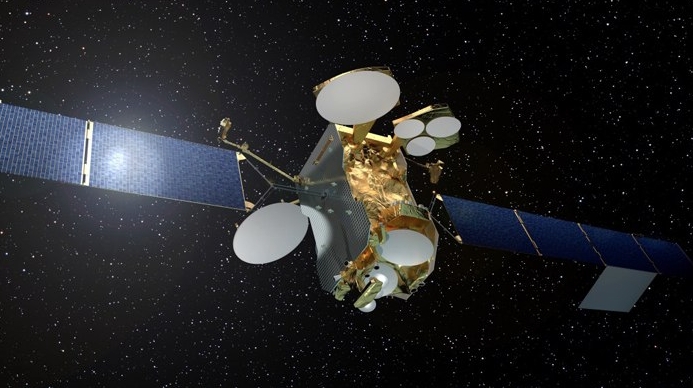
Photo credit : EUTELSAT 172B artist view (Airbus Defence and Space)
It's a first for an all-electric propulsion for orbit-raising and on-station maneuvers for the first time on a high power satellite. This is also reflected in the significant mass savings on this class of mission.
Airbus Defense and Space's Statement
EUTELSAT 172B, the first high power all-electric telecommunications satellite worldwide built by Airbus for Eutelsat has been successfully launched from Kourou, French Guiana by Ariane 5. The satellite will provide enhanced telecommunications, in-flight broadband and broadcast services for the Asia-Pacific region.
“We are the first company to demonstrate full electric propulsion for satellites of this size and capacity,” said Nicolas Chamussy, Head of Space Systems at Airbus. “With this spacecraft we are clearly setting a new benchmark — enabling powerful and complex satellites to be launched in the most cost efficient manner.”
EUTELSAT 172B combines electric power of 13 kW with a launch mass of around 3,500 kg only, thanks to the latest EOR (Electric Orbit Raising) version of Airbus’ highly reliable Eurostar E3000 platform.
Full electric propulsion for initial orbit raising and all on-station manoeuvres, with Xenon gas ejected at high speed using only electric power supplied by solar cells, relieves operators of the need to include tons of chemical propellant, leading to up to 40% mass savings on the satellite.
Customers can therefore either achieve a significant saving on launch costs, or a substantial increase of the payload power for a given mass. Furthermore the Hall Effect Technology used by Airbus makes transfer to the operational orbit significantly faster than other electric propulsion technologies.
Innovation solutions include two deployable robotic arms to orientate the satellite’s electric propulsion thrusters to control thrust direction and attitude during different phases of the mission. In addition, WALIS (Wide Angle Localisation Integrated System) is a proprietary network of ground stations developed by Airbus around the world, to enable Airbus engineers to control orbit raising operations until the satellite reaches geostationary orbit.
The development of Airbus’ Eurostar all electric satellites has been supported by ESA and space agencies of European countries, in particular in France by CNES in the framework of the PIA programme (Plan d’Investissements d’Avenir) and in the UK by the UK Space Agency.
EUTELSAT 172B hosts three distinct payloads that will strengthen Eutelsat’s capabilities across Asia-Pacific markets: a C-band payload, a regular Ku-band payload and a high throughput Ku-band payload designed for in-flight connectivity along Pacific air corridors.
In that regard, the satellite features an innovative multi-port amplifier (MPA) on the payload to distribute dynamically the satellite’s power between its 11 spot beams to provide internet connectivity for aircraft flying across the Asia-Pacific region.
The flexibility of the MPA means that more power can be allocated to each spot beam as demand increases giving aircraft passengers a better service. The MPA technology was developed by Airbus as part of the European Space Agency’s Advanced Research in Telecommunications Systems programme and supported by the UK Space Agency.
Additive layer manufacturing, or 3D printing, is further exploited for several elements on this satellite, including for a single printed bracket that is 35% lighter than and quicker to manufacture than the complex component it replaced.

